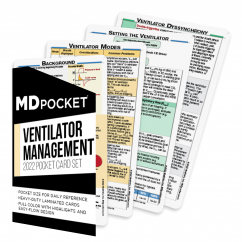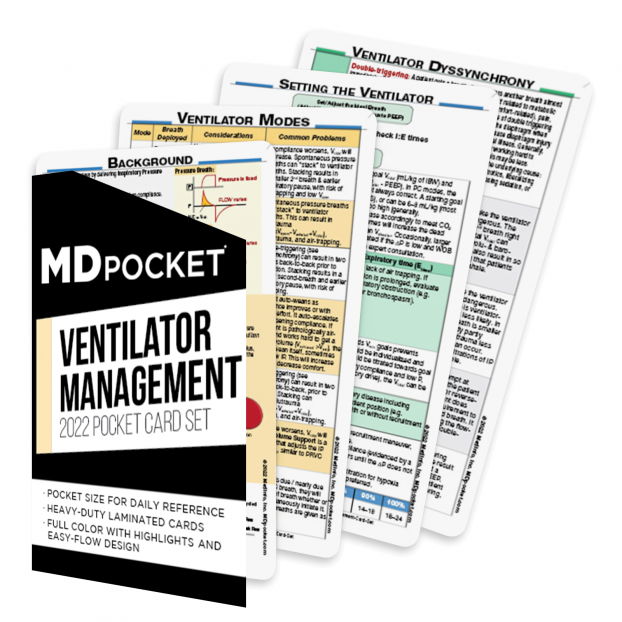
MDpocket Ventilator Management Card Set
Learning how to expertly manage a ventilator is one of the most challenging skills required in intensive care. Unfortunately, ventilator education often skips the basics and teaches Modes and Settings, instead of teaching The Breath. By teaching the breath as the base of the pyramid, modes and dysynchrony become much easier to understand and manage at the bedside. Further, optimizing PEEP and adjusting ventilators to each individual patient becomes not only possible, but simple. In addition to teaching ventilator breaths and modes, these cards review how to set the ventilator, adjust it to each individual patient and how to identify and treat ventilator dyssynchrony. Additional pages tackle APRV, from risks and benefits, to initial settings, to titration and weaning, and ARDS. These cards were created during the COVID surge to assist non-intensivists in managing ventilators, and they are a must-have for quick and easy reference for these complex topics.
Ventilator Breaths/Ventilator Modes:
1 The ventilator itself delivers flow at all times. “Pressure Delivered” here means the ventilator simply increases/decreases airflow, rapidly titrating to the goal pressure. This is fast and for practical purposes can be ignored.
2 Pressure regulated volume control has a variety of names: volume auto-flow (VAF), Pressure Control-Plus (PC+), and more.
Ventilator Modes:
1 Based on the ventilator brand, either the I:E or the Itime is set by the user.
Airway Pressure Release Ventilation:
1 Other names include: BiLevel(Covidien), Bi-Vent (Maquet), BiPhasic (Carefusion) and DuoPAP (Hamilton).
2 Zhou Y, Jin X, Yinxia L, et al. Early application of airway pressure release ventilation may reduce the duration of mechanical ventilation in acute respiratory distress syndrome. Intensive Care Med. 2017;43(11):1648-59.
3 Haines K, McDermott K, Wheelock L, Breihan P, Sprague K, Long MT, Agarwal S and Jung HS. Are Lung Protective tidal volumes necessary in APRV? Crit Care Med. 2018;l46(1):780.
4 A more accurate T-low can be done with calculation of (tau, the time constant); t = Resistance (cmH2O/L/s) x Compliance (L/cmH2O). Start with T-low ~ 1–1.5. Next, titrate T-low to stop exhalation at ≥50% of the PEFR.
Setting the Ventilator:
X ARDS is a catch-all here; lung protective measures should be pursued in all patients and low volumes used in any patient with poor pulmonary compliance.
1 Millington SJ, Cardinal P & Brochard L. Setting and titrating PEEP. Chest. 2022;S0012-3692(22):00220-3.
2 This & the ARDSnet Algorithm can be found here: http://www.ardsnet.org/files/ventilator_protocol_2008-07.pdf
Acute Respiratory Distress Syndrome:
1 Papazian L, Aubron C, Brochard L, el al. Formal guidelines: management of acute respiratory distress syndrome. Ann intensive Care. 2019;9(1) 69.
2 The ARDS Definition Task Force*. Acute respiratory distress syndrome: the Berlin definition, JAMA. 2012;3072526-33.
3 The ARDSnet Algorithm can be found here: http://www.ardsnet.org/files/ventilator_protocol_2008-07.pdf
4 Amato MBP, Meade MO, Slutsky AS, et al. Driving pressure and survival in the acute respiratory distress syndrome. Nejm. 2013;368:2159-68.
5 Villar J, Ferrando C, Martínez D, et al. Dexamethasone treatment for the acute respiratory distress syndrome: a multicentre, randomised controlled trial. Lancet Respir Med. 2020;8(3):267-76.
6 Guérin C, Reignier J, Richard JC, et al, PROSEVA Study Group. Prone positioning in severe acute respiratory distress syndrome. NEJM. 2013;368:2159-68.
7 Gebistorf F, Karam O, Wetterslev J & Afshari A. Inhaled nitric oxide for acute respiratory distress syndrome (ARDS) in children and adults. Cocrane Database Sys Rev. 2016(6):CD002787.
8 Slutsky AS & Villar J Early paralytic agents for ARDS? Yes, NO, and Sometimes. NEJM. 2019;380:2061-3.
9 Nickson C. Lung recruitment manoreuvres in ARDS. Life in the Fast Lane. 11/3/2020. Accessed 9?23/2021. litfl.com/lung-recruitment- manoeuvres/
10 Bullen EC. Teiierio paradis R & Fan E. How I select which patients with ARDS Should be treated with venovenous 3530252015P<0.0012.52.01.51.00.50.0105
Ventilator Dyssynchrony (1):
1 De Haro C, Ochagavia A, Lopez-Aguilar J et al. Patient-ventilator asynchronies during mechanical ventilation: current knowledge and research priorities. Intensive Care Medicine Experimental. 2019; 7(Suppl 1):43.

All formats available:
Get this card as an eCard, a physical card or both! Just select the items you want in the ‘Options & Accessories’ section above.

Available anytime, anywhere:
Access your eCards using the MyHospital® App on your smartphone! All reference material can be accessed at anytime and anywhere with wifi or data!

Get your card instantly!:
Immediately after purchase your reference cards are available in the MyHospital® app on Android or IOS devices!
Make sure you get the perfect eReference material for you! Click here for our Medical Reference Guides!
Price in reward points: 2125
MDpocket Ventilator Management Card Set
Learning how to expertly manage a ventilator is one of the most challenging skills required in intensive care. Unfortunately, ventilator education often skips the basics and teaches Modes and Settings, instead of teaching The Breath. By teaching the breath as the base of the pyramid, modes and dysynchrony become much easier to understand and manage at the bedside. Further, optimizing PEEP and adjusting ventilators to each individual patient becomes not only possible, but simple. In addition to teaching ventilator breaths and modes, these cards review how to set the ventilator, adjust it to each individual patient and how to identify and treat ventilator dyssynchrony. Additional pages tackle APRV, from risks and benefits, to initial settings, to titration and weaning, and ARDS. These cards were created during the COVID surge to assist non-intensivists in managing ventilators, and they are a must-have for quick and easy reference for these complex topics.
Ventilator Breaths/Ventilator Modes:
1 The ventilator itself delivers flow at all times. “Pressure Delivered” here means the ventilator simply increases/decreases airflow, rapidly titrating to the goal pressure. This is fast and for practical purposes can be ignored.
2 Pressure regulated volume control has a variety of names: volume auto-flow (VAF), Pressure Control-Plus (PC+), and more.
Ventilator Modes:
1 Based on the ventilator brand, either the I:E or the Itime is set by the user.
Airway Pressure Release Ventilation:
1 Other names include: BiLevel(Covidien), Bi-Vent (Maquet), BiPhasic (Carefusion) and DuoPAP (Hamilton).
2 Zhou Y, Jin X, Yinxia L, et al. Early application of airway pressure release ventilation may reduce the duration of mechanical ventilation in acute respiratory distress syndrome. Intensive Care Med. 2017;43(11):1648-59.
3 Haines K, McDermott K, Wheelock L, Breihan P, Sprague K, Long MT, Agarwal S and Jung HS. Are Lung Protective tidal volumes necessary in APRV? Crit Care Med. 2018;l46(1):780.
4 A more accurate T-low can be done with calculation of (tau, the time constant); t = Resistance (cmH2O/L/s) x Compliance (L/cmH2O). Start with T-low ~ 1–1.5. Next, titrate T-low to stop exhalation at ≥50% of the PEFR.
Setting the Ventilator:
X ARDS is a catch-all here; lung protective measures should be pursued in all patients and low volumes used in any patient with poor pulmonary compliance.
1 Millington SJ, Cardinal P & Brochard L. Setting and titrating PEEP. Chest. 2022;S0012-3692(22):00220-3.
2 This & the ARDSnet Algorithm can be found here: http://www.ardsnet.org/files/ventilator_protocol_2008-07.pdf
Acute Respiratory Distress Syndrome:
1 Papazian L, Aubron C, Brochard L, el al. Formal guidelines: management of acute respiratory distress syndrome. Ann intensive Care. 2019;9(1) 69.
2 The ARDS Definition Task Force*. Acute respiratory distress syndrome: the Berlin definition, JAMA. 2012;3072526-33.
3 The ARDSnet Algorithm can be found here: http://www.ardsnet.org/files/ventilator_protocol_2008-07.pdf
4 Amato MBP, Meade MO, Slutsky AS, et al. Driving pressure and survival in the acute respiratory distress syndrome. Nejm. 2013;368:2159-68.
5 Villar J, Ferrando C, Martínez D, et al. Dexamethasone treatment for the acute respiratory distress syndrome: a multicentre, randomised controlled trial. Lancet Respir Med. 2020;8(3):267-76.
6 Guérin C, Reignier J, Richard JC, et al, PROSEVA Study Group. Prone positioning in severe acute respiratory distress syndrome. NEJM. 2013;368:2159-68.
7 Gebistorf F, Karam O, Wetterslev J & Afshari A. Inhaled nitric oxide for acute respiratory distress syndrome (ARDS) in children and adults. Cocrane Database Sys Rev. 2016(6):CD002787.
8 Slutsky AS & Villar J Early paralytic agents for ARDS? Yes, NO, and Sometimes. NEJM. 2019;380:2061-3.
9 Nickson C. Lung recruitment manoreuvres in ARDS. Life in the Fast Lane. 11/3/2020. Accessed 9?23/2021. litfl.com/lung-recruitment- manoeuvres/
10 Bullen EC. Teiierio paradis R & Fan E. How I select which patients with ARDS Should be treated with venovenous 3530252015P<0.0012.52.01.51.00.50.0105
Ventilator Dyssynchrony (1):
1 De Haro C, Ochagavia A, Lopez-Aguilar J et al. Patient-ventilator asynchronies during mechanical ventilation: current knowledge and research priorities. Intensive Care Medicine Experimental. 2019; 7(Suppl 1):43.

All formats available:
Get this card as an eCard, a physical card or both! Just select the items you want in the ‘Options & Accessories’ section above.

Available anytime, anywhere:
Access your eCards using the MyHospital® App on your smartphone! All reference material can be accessed at anytime and anywhere with wifi or data!

Get your card instantly!:
Immediately after purchase your reference cards are available in the MyHospital® app on Android or IOS devices!
Make sure you get the perfect eReference material for you! Click here for our Medical Reference Guides!
| Card | |
| Quantity | 4 double sided card |
| Size | 6" L x 3.75" W x 0.12" H |
| Weight | 0.25 lbs |
| Date | |
| Published | 7/19/2025 |

